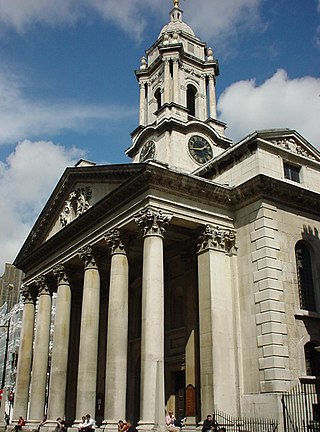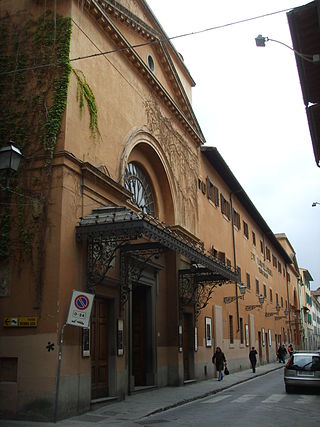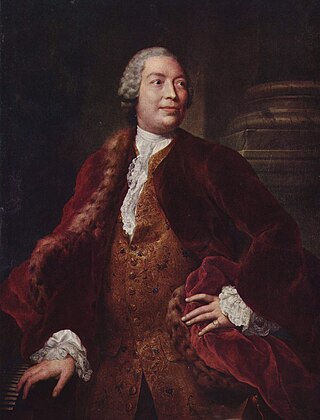
Giuseppe Domenico Scarlatti, also known as Domingo or Doménico Scarlatti, was an Italian composer. He is classified primarily as a Baroque composer chronologically, although his music was influential in the development of the Classical style. Like his renowned father Alessandro Scarlatti, he composed in a variety of musical forms, although today he is known mainly for his 555 keyboard sonatas. He spent much of his life in the service of the Portuguese and Spanish royal families.

Bernardo Pasquini was an Italian composer of operas, oratorios, cantatas and keyboard music. A renowned virtuoso keyboard player, he was one of the most important Italian composers for harpsichord between Girolamo Frescobaldi and Domenico Scarlatti, having also made substantial contributions to the opera and oratorio.
Ignaz Jakob Holzbauer was an Austrian composer of symphonies, concertos, operas, and chamber music, and a member of the Mannheim school. His aesthetic style is in line with that of the Sturm und Drang "movement" of German art and literature.

Pietro Ottoboni was an Italian cardinal and grandnephew of Pope Alexander VIII, who was also born Pietro Ottoboni. He is remembered especially as a great patron of music and art. Ottoboni was the last person to hold the curial office of Cardinal-nephew, which was abolished by Alexander's successor, Pope Innocent XII, in 1692. Ottoboni '"loved pomp, prodigality, and sensual pleasure, but was in the same time kind, ready to serve and charitable".

Thomas Roseingrave, like his father Daniel Roseingrave, was an English-born Irish composer and organist.

Carlo Francesco Pollarolo was an Italian composer, organist, and music director. Known chiefly for his operas, he wrote a total of 85 of them as well as 13 oratorios. His compositional style was initially indebted to the opera tradition of Giovanni Legrenzi and Carlo Pallavicino, but he moved beyond this style with innovations to the compositional structure of the aria characterized by expanded forms and orchestral elaborations. His early work used three part strings in the Legrenzi and Pallacino tradition of orchestration, but his mid and later works had developed into a richer orchestration of five strings parts and expanded instrumentation of brass and woodwinds. He was the first Venetian opera composer and one of the earliest Italian composers to use the oboe in his opera orchestrations.

Caterina Gabrielli, born Caterina Fatta, was an Italian coloratura singer. She was the most important soprano of her age. A woman of great personal charm and dynamism, Charles Burney referred to her as "the most intelligent and best-bred virtuosa" that he had ever encountered. The excellence of her vocal artistry is reflected in the fact that she was able to secure long-term engagements in three of the most prestigious operatic centers in her day outside of Italy.

Antonio Salvi was an Italian physician, court poet and librettist, active mainly in Florence, Italy. He was in the service of the grand-ducal court of Tuscany and the favourite librettist of Prince Ferdinando de' Medici. Salvi was one of the developers of the opera seria.

Gennaro Manna was an Italian composer based in Naples. He was a member of the Neapolitan School. His compositional output includes 13 operas and more than 150 sacred works, including several oratorios.

Domenico Annibali was an Italian castrato who had an active international career from 1725–1764. He began his career in his native country and was then committed to the Grosses Königliches Opernhaus in Dresden from 1729 until his retirement from the stage 35 years later. In Dresden he excelled in the operas of Johann Adolph Hasse, notably creating roles in the premieres of two of his operas. He was also admired there in works by Nicola Porpora.
La passione di Gesù Cristo is a libretto by Pietro Metastasio which was repeatedly set as an azione sacra or oratorio by many composers of the late baroque, Rococo and early classical period.

Télémaque et Calypso, also Télémaque or [French: ou] Calypso, is an opera by the French composer André Cardinal Destouches, first performed at the Académie Royale de Musique on 29 November 1714. It takes the form of a tragédie en musique in a prologue and five acts.

Tito e Berenice is an opera in three acts composed by Antonio Caldara to a libretto by Carlo Sigismondo Capece. It premiered on 10 January 1714 at the Teatro Capranica in Rome. The story centers on the love affair between Berenice of Cilicia and the future Roman Emperor Titus. The libretto borrows from earlier plays on the same subject by Corneille and Racine (Bérénice), both of which premiered in 1670 and took as their starting point Suetonius's brief account of the love affair in De vita Caesarum.

The Teatro Capranica is a theatre situated at 101 Piazza Capranica in the Colonna district of Rome. Originally constructed in 1679 by the Capranica family and housed in the early Renaissance Palazzo Capranica, it was the second public theatre to open in Rome. It was the site of many premieres of Baroque operas including Caldara's Tito e Berenice, Scarlatti's Griselda, and Vivaldi's Ercole su'l Termodonte. The Capranica ceased operating as a full-scale theatre and opera house in 1881 and in 1922 was converted into a cinema. Following the closure of the cinema in 2000, it has functioned on a hire basis as a conference and performance venue.

Sebastiano Biancardi, known by the pseudonym Domenico Lalli, was an Italian poet and librettist. Amongst the many libretti he produced, largely for the opera houses of Venice, were those for Vivaldi's Ottone in villa and Alessandro Scarlatti's Tigrane. A member of the Accademia degli Arcadi, he also wrote under his arcadian name "Ortanio". Lalli was born and raised in Naples as the adopted son of Fulvio Caracciolo but fled the city after being implicated in a bank fraud. After two years wandering about Italy in the company of Emanuele d'Astorga, he settled in Venice in 1710 and worked as the "house poet" of the Grimani family's theatres for the rest of his career. In addition to his stage works, Lalli published several volumes of poetry and a collection of biographies of the kings of Naples. He died in Venice at the age of 62.
Ifigenia in Aulide may refer to:

Telemaco, ossia L'isola di Circe is a 1718 opera by Alessandro Scarlatti to a libretto by Carlo Sigismondo Capece, court poet to Queen Maria Casimira of Poland, living in exile in Rome, for the Teatro Capranica in Rome, where it was premiered during the carnival season. The opera was revived in 2005 by the Schwetzingen Festival and the Deutsche Oper am Rhein.
Tolomeo e Alessandro, ovvero la corona disprezzata is an Italian-language opera by Domenico Scarlatti to a libretto by Carlo Sigismondo Capece which premiered in Rome on 19 January 1711 at the Palazzo Zuccari, with scenery by Filippo Juvarra. It was second of the seven operas composed by Domenico for the Polish queen Maria Casimira Sobieski, following his pastorale in three acts La Silvia of 27 January 1710.
Carlo Sigismondo Capece was an Italian dramatist and librettist. Capece was court poet to Queen Maria Casimira of Poland, who was living in exile in Rome, and is best remembered today for the libretto of La resurrezione a sacred oratorio by George Frideric Handel. He also provided the Libretto for operas including Domenico Scarlatti's Tolomeo e Alessandro (1711) and Ifigenia in Aulide (1714), as well as Caldara's Tito e Berenice (1714).














